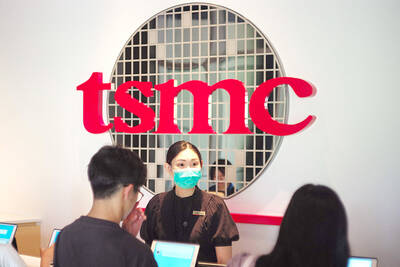Taiwan Mobile Co (台灣大哥大) reported an annual increase in revenue and net profit for the first two months of this year, bucking a downtrend in the industry amid high 5G spectrum costs and price competition.
The company’s net profit increased 11.5 percent to NT$2.27 billion (US$75.43 million) for the two months from NT$2.04 billion a year earlier. That translated into earnings per share of NT$0.81, up from NT$0.75 last year.
Revenue increased 7.12 percent to NT$21.36 billion for the first two months, up from NT$19.94 billion a year earlier, Taiwan Mobile said in a statement on Tuesday.
The company attributed the growth to the contribution of its e-commerce unit, Momo.com Inc (富邦媒體), which posted a 33 percent annual expansion in revenue, as people staying at home amid the coronavirus crisis shopped more online or on TV shopping channels.
During January and last month, Taiwan Mobile had higher earnings per share than Chunghwa Telecom Co’s (中華電信) NT$0.73 and Far EasTone Telecommunications Co’s (遠傳電信) NT$0.44.
The company’s financials “show that the company is the only telecom that managed to increase revenue and net profit,” Taiwan Mobile president Jamie Lin (林之晨) wrote on Facebook yesterday.
Strong growth at Momo.com helped the company sidestep a slump in the telecom industry, Lin added.
Chunghwa Telecom’s net profit in the first two months fell 3.2 percent year-on-year to NT$5.64 billion from NT$5.82 billion a year earlier, while revenue fell 4.6 percent to NT$32.57 billion from NT$34.15 billion, a company statement said on Tuesday.
Far EasTone’s net profit in the first two months fell 2.03 percent year-on-year to NT$1.45 billion from NT$1.48 billion a year earlier, while revenue fell 5.5 percent to NT$13.05 billion from NT$13.81 billion.
Telecoms need to own between 80 megahertz (MHz) and 100MHz on the 5G spectrum to deliver high-speed data transmission, Far EasTone said last week, hinting that Taiwan Mobile might no longer be one of the nation’s big three telecoms after it secured 60MHz of 5G bandwidth in the 3.5 gigahertz (GHz) band in the national auction, smaller than Far EasTone’s 80MHz of bandwidth and Chunghwa Telecom’s 100MHz.

Taiwan Transport and Storage Corp (TTS, 台灣通運倉儲) yesterday unveiled its first electric tractor unit — manufactured by Volvo Trucks — in a ceremony in Taipei, and said the unit would soon be used to transport cement produced by Taiwan Cement Corp (TCC, 台灣水泥). Both TTS and TCC belong to TCC International Holdings Ltd (台泥國際集團). With the electric tractor unit, the Taipei-based cement firm would become the first in Taiwan to use electric vehicles to transport construction materials. TTS chairman Koo Kung-yi (辜公怡), Volvo Trucks vice president of sales and marketing Johan Selven, TCC president Roman Cheng (程耀輝) and Taikoo Motors Group

Among the rows of vibrators, rubber torsos and leather harnesses at a Chinese sex toys exhibition in Shanghai this weekend, the beginnings of an artificial intelligence (AI)-driven shift in the industry quietly pulsed. China manufactures about 70 percent of the world’s sex toys, most of it the “hardware” on display at the fair — whether that be technicolor tentacled dildos or hyper-realistic personalized silicone dolls. Yet smart toys have been rising in popularity for some time. Many major European and US brands already offer tech-enhanced products that can enable long-distance love, monitor well-being and even bring people one step closer to

RECORD-BREAKING: TSMC’s net profit last quarter beat market expectations by expanding 8.9% and it was the best first-quarter profit in the chipmaker’s history Taiwan Semiconductor Manufacturing Co (TSMC, 台積電), which counts Nvidia Corp as a key customer, yesterday said that artificial intelligence (AI) server chip revenue is set to more than double this year from last year amid rising demand. The chipmaker expects the growth momentum to continue in the next five years with an annual compound growth rate of 50 percent, TSMC chief executive officer C.C. Wei (魏哲家) told investors yesterday. By 2028, AI chips’ contribution to revenue would climb to about 20 percent from a percentage in the low teens, Wei said. “Almost all the AI innovators are working with TSMC to address the

Malaysia’s leader yesterday announced plans to build a massive semiconductor design park, aiming to boost the Southeast Asian nation’s role in the global chip industry. A prominent player in the semiconductor industry for decades, Malaysia accounts for an estimated 13 percent of global back-end manufacturing, according to German tech giant Bosch. Now it wants to go beyond production and emerge as a chip design powerhouse too, Malaysian Prime Minister Anwar Ibrahim said. “I am pleased to announce the largest IC (integrated circuit) Design Park in Southeast Asia, that will house world-class anchor tenants and collaborate with global companies such as Arm [Holdings PLC],”